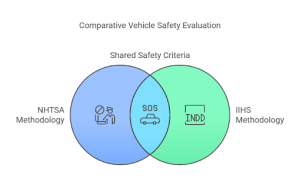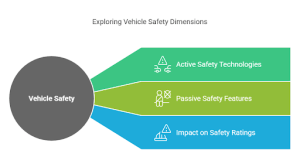Car Safety Ratings: A Comprehensive Guide
Between these, massive vehicular accidents perpetrate thousands in the U.S., injuring and killing. NHTSA reported that in 2020 alone, vehicle crashes have taken away 38,000 lives and more. Thus, statistics impose a strong need to keep such safety vetting in mind when choosing a vehicle.
Car safety ratings are among the best tools for comparing the safety of different vehicles. This helps the consumer make a good decision on vehicles based on safety for themselves and their families. This guide is meant to give a broad overview of car safety ratings to those over 25 years old residing in the U.S., with a great emphasis on safety when it comes to choosing a car.
Why Car Safety Ratings Matter
The Importance of Safety
Safety is a critical consideration for drivers and passengers. Modern vehicles incorporate advanced safety features to reduce the risk of injuries and fatalities in accidents. Safety ratings measure the effectiveness of these features and compare vehicles on a standardized scale.
The Role of Ratings
Safety ratings are conducted by reputable organizations, such as:
- National Highway Traffic Safety Administration (NHTSA): This agency provides a 5-star rating system focusing on crashworthiness and crash avoidance.
- Insurance Institute for Highway Safety (IIHS): This organization offers ratings based on crash tests and awards vehicles as Top Safety Picks.
These ratings help consumers identify vehicles with superior safety performance.
Understanding U.S. Car Safety Rating Systems
Overview of Rating Organizations
National Highway Traffic Safety Administration (NHTSA)
The NHTSA evaluates vehicles based on crash tests, including:
- Frontal crashes
- Side-impact crashes
- Rollover resistance
Insurance Institute for Highway Safety (IIHS)
The IIHS uses crash tests and advanced safety evaluations to award vehicles with Top Safety Pick and Top Safety Pick+ designations.
How Ratings Are Determined
NHTSA Methodology
- Frontal crash tests: Simulate head-on collisions.
- Side-impact tests: Evaluate safety from T-bone crashes.
- Rollover resistance tests: Assess the likelihood of a vehicle tipping over.
IIHS Methodology
- Small overlap and moderate overlap frontal tests: Evaluate crash protection.
- Side crash tests: Assess occupant protection.
- Roof strength tests: Measure resistance in rollovers.
- Head restraint tests: Evaluate protection against neck injuries.
The ratings are assigned via NHTSA and I, using a 5-star system for the former and a four-category system for the latter: Goodood, Acceptable, Marginal, and Poor.
Key measures: A combination of occupant protection, distribution of force on the hardware during a crash, and availability of regulation safety features.

Key metrics include occupant protection, crash force distribution, and effectiveness of safety features.
Modern Vehicle Safety Features
Active Safety Technologies
Modern vehicles are equipped with advanced technologies to prevent accidents, including:
- Automatic Emergency Braking (AEB): Applies brakes to avoid collisions.
- Lane Departure Warning (LDW): Alerts drivers when drifting out of lanes.
- Blind-Spot Monitoring: Detects vehicles in blind spots.
- Adaptive Cruise Control: Maintains safe distances from other vehicles.
Passive Safety Features
These features lessen the severity of injuries in the event of a crash. Some components include:
- Airbags: Cushion the occupant or passenger at the point of impact.
- Seatbelts: Hold passengers in place and prevent them from being thrown forward at impact.
- Crumple Zones: Help the car absorb some of the energy of impact.
What Influence Do Safety Ratings Have?
Vehicles equipped with advanced safety features often receive higher ratings. AEB, for example, has a vast influence on IIHS ratings.

Safety Comparison Between Different Vehicle Types
Sedans vs. SUVs vs. Trucks
- Sedans: Generally smaller, with less rollover risk; crash test ratings consider all factors.
- SUVs are more effective in providing passenger protection during multi-vehicle collisions but have an increased risk of rollover.
- Trucks: Durable but may lack some safety features compared to sedans and SUVs.
Small Car versus Large Car
- Small Cars: Smaller crumple zones could hinder performance in crash tests.
- Large Cars: Do better during crash incidents but may be unwieldy.
Different Needs Addressed
- Families: They prefer SUVs or minivans because of their spaciousness and child safety features.
- Commuters: Go for sedans with high safety ratings and fuel efficiency.
Safety Ratings Versus Real-Life Performance
Safety ratings shed a great deal of light on the situation but do not reckon for:
- Driver behavior
- Weather condition
- Real-life accident circumstances
Real Accident Information
NHTSA and similar organizations collect data from real-world accidents to validate safety ratings. This data illustrates a fuller picture of the vehicle’s safety.
Safety for Different Age Groups and Passengers
Child Passenger Safety
Proper car seats are essential for child safety. Some tips include:
- Installing the car seat according to NHTSA regulations.
- Using a car seat suitable for the child’s age.
The Safety of Older Adults
Older drivers benefit from:
- Adjustable seats
- Easily readable dashboard illumination
- Good braking systems
Safety for Passengers with Special Needs
Well-designed vehicles with wheelchair access and adaptive controls allow persons with physical disabilities to operate vehicles safely.
Long-Term Vehicle Safety and Reliability
Maintenance of the Safety Features
Regular maintenance prevents deterioration. Key practices include:
- Ensure the airbag systems are working.
- Check the seatbelts for wear and tear.
- Periodically check anti-lock brakes.
Safety Expectancies in General
- Regular checks of tires, brakes, and lights.
Future Car Safety
Emerging Technology
- Automated vehicles: AI-enabled systems to eliminate human errors in vehicle operation.
- Connected cars: Communication connections between those vehicles for safe travel.
- ADAS: These systems give the driver more awareness of everything around the vehicle.
Impact on Future Scores
ADAS and autonomous systems will improve safety and influence future rating choices.
Future Safety Regulations
These may cover anything from pedestrian detection to AEB in almost every vehicle.
Expert Tips and Practical Advice
How to Read the Ratings
- The idea is simple: Focus on the overall score and specific criteria to address your needs.
- Look for consistent performance across crash tests.
Making Informed Purchasing Decisions
- Prioritize vehicles with advanced safety features.
- Consider both safety ratings and real-world reliability data.
Safe Driving Habits
- Always wear seatbelts.
- Avoid distractions while driving.
- Adhere to speed limits and road rules.
Conclusion
Knowing a vehicle’s safety ratings when buying one is very important. Covers, passengers, and loved ones can easily assess vehicles for their impressive features by combining information from sources like NHTSA and IIHS with automobile crash incidents. Stay informed of emerging technologies and practice safe driving habits to keep the roads safer.

























